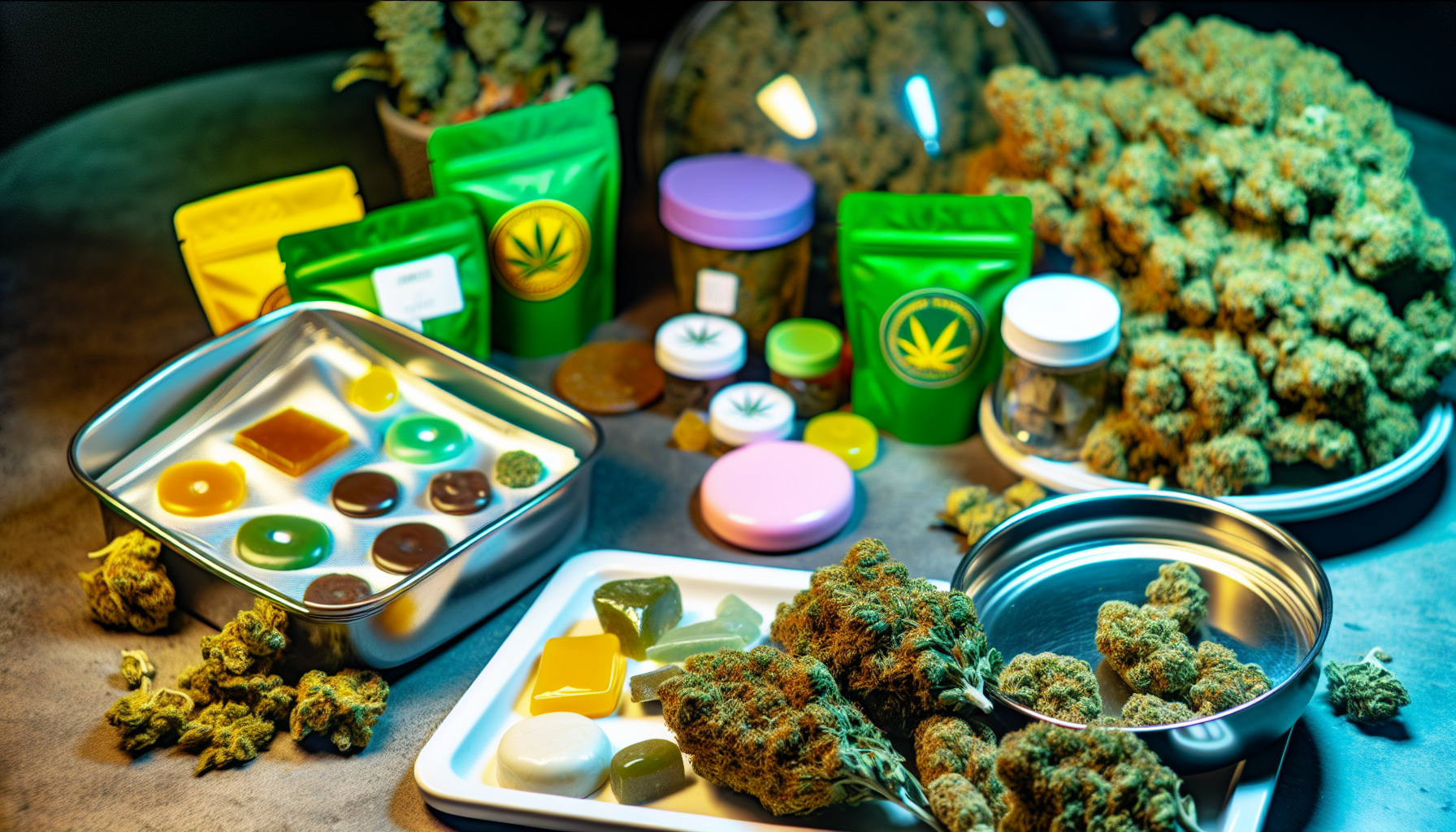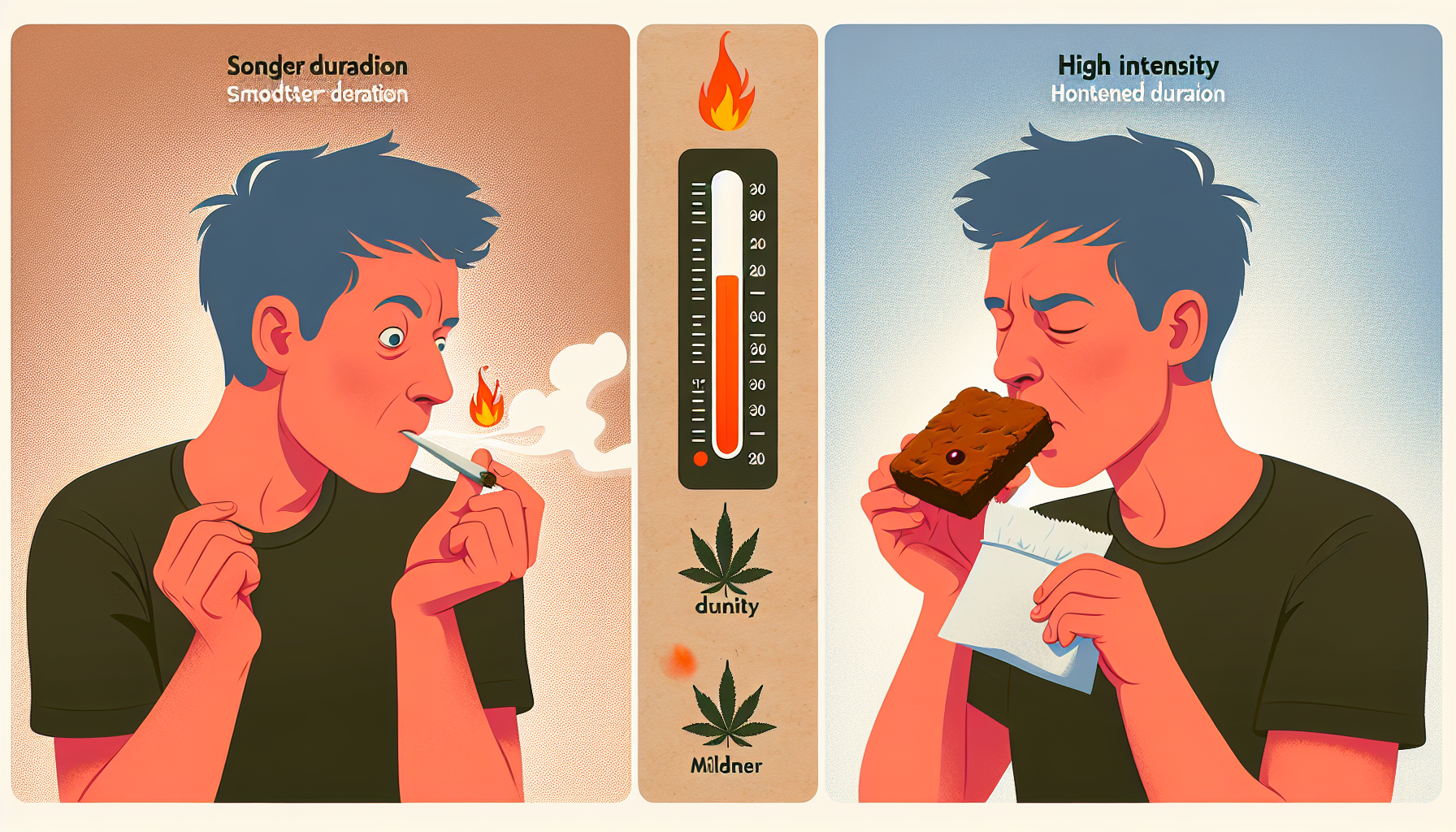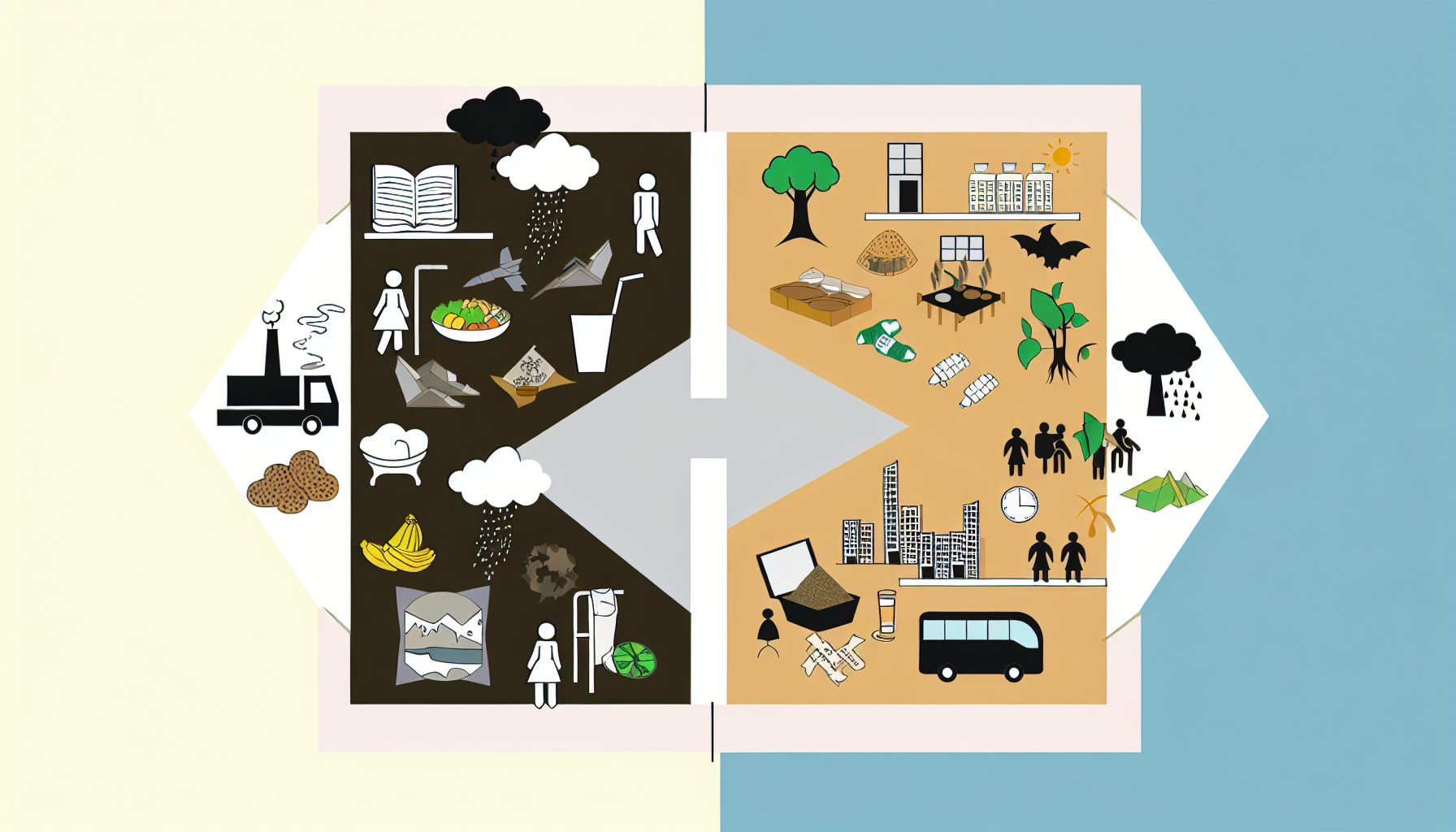Smoking vs Edibles: Navigating Your Best Cannabis Experience
Dec 13, 2023
The world of cannabis consumption is as diverse as it is intriguing. There’s an exhilarating range of experiences awaiting those who dare to explore, from the instant gratification of smoking to the slow and steady build of edibles. But which method offers the best cannabis experience? This is the question we aim to answer as we delve deep into the intricacies of smoking vs edibles, comparing their effects, safety, social and legal implications, cost, and convenience. So, strap in and join us on this enlightening journey.
Key Takeaways
-
This article explores the differences between inhaling and ingesting cannabis, including effects, duration, dosage and potential for Research.
-
The intensity of the cannabis experience is determined by a variety of factors such as method of consumption which can influence potency, speed & duration.
-
The social/legal landscape impacts experiences with smoking vs edibles. Exercising control & following recommended dosages are important to prevent overindulgence or accidental overdosing.
Inhale or Ingest: Understanding the Basics

Cannabis consumption is an art, with each method offering a unique canvas on which to paint your experiences. Whether it’s lighting up a joint or biting into a cannabis-infused cookie, the choice between smoking and eating edibles can significantly impact your cannabis journey.
Smoking marijuana provides immediate effects, typically lasting 1 to 3 hours, making it a favorite for those seeking instant gratification. On the other hand, ingesting cannabis through edibles offers a slow-burning experience. The effects take longer to kick in but can last for 6 to 12 hours, providing a steady and prolonged high. However, edibles present a challenge in achieving consistent dosage, as the body metabolizes THC differently, leading to varying effects across different individuals and batches of products. The lingering questions surrounding the effects of cannabis-infused edibles underscore the need for further research and informed regulations.
The Journey of Smoke
The process of smoking marijuana is akin to lighting a fuse, resulting in an immediate explosion of effects. When you smoke cannabis, THC enters the bloodstream via the lungs, sparking an almost instantaneous high. It’s like turning on a light switch - one moment you’re in the dark, the next you’re bathed in a warm, all-encompassing glow.
However, like a firework display, the spectacle is short-lived. The rapid onset of effects from smoking cannabis is accompanied by a shorter duration, making it a fleeting, albeit intense, experience. It’s a roller coaster ride that takes you to dizzying heights before bringing you back to earth in a matter of a few hours.
Edibles and the Digestive Pathway
Cannabis edibles, on the other hand, offer a different kind of journey. If smoking is a roller coaster, then ingesting cannabis is a scenic train ride - slow, steady, and lasting for hours. Edibles are absorbed through the digestive tract and liver, resulting in a notably prolonged absorption of THC into the bloodstream and its impact on the brain.
The delayed onset of effects from edibles can make for a suspenseful wait. It’s like watching a pot of water come to a boil - it seems to take forever, but when it finally happens, the effects are intense and long-lasting. And that’s not all. The liver converts THC into a more potent form, which means that a specific amount of THC consumed through edibles typically results in a stronger effect compared to the same quantity smoked. It’s a slow-burning fuse that leads to a grand finale.
The Highs and Lows: Comparing Effects

Having explored the basic mechanisms of smoking and ingesting cannabis, let’s take a closer look at how these methods compare in terms of effects. The highs and lows of your cannabis experience depend largely on your choice of consumption method, with each offering its unique blend of sensations.
Smoking cannabis, or smoking weed, can be likened to a sprint - it’s quick, intense, and over before you know it. The effects are immediate and strong, but their duration is relatively short.
On the other hand, ingesting cannabis through edibles is more like a marathon - it takes time to build up, but the effects are longer lasting and potentially more intense, thanks to the liver’s conversion of THC into a more potent form.
Duration Dynamics
The saying “time flies when you’re having fun” seems particularly apt when discussing the duration of cannabis effects. The intoxicating effects from smoking cannabis are of a short-term nature, generally less substantial in duration when compared to edibles, which can persist for an average of 6-8 hours. This makes edibles a preferred choice for medical patients seeking longer-lasting relief.
The onset and peak time of the high from smoking cannabis come almost immediately, making it a favored method for those seeking instant gratification. However, awareness of the potential risks associated with high doses and frequent use, which may lead to drug abuse and the need for marijuana addiction treatment, is necessary.
On the other hand, the effects of different types of edible cannabis products can exhibit varying durations, typically initiating between 30 minutes to 2 hours and lasting up to 12 hours.
Intensity of Impact
The intensity of your cannabis experience can be likened to the volume knob on your stereo - it can vary from a gentle background hum to a full-blown party blast. And just like your choice of music can set the mood for the evening, your choice of cannabis consumption method can significantly impact the intensity of your high.
The cannabis active compounds, such as THC from smoking cannabis, are rapidly absorbed into the bloodstream, resulting in immediate and intense effects. However, when cannabis is ingested, the THC undergoes a metabolic process in the liver, leading to a slower onset but potentially resulting in a more potent high. It’s like choosing between a quick sprint and a steady uphill climb - both can leave you breathless, but the intensity and duration of the experience can greatly differ.
Health Horizon: Safety and Risks

As with any journey, prioritizing safety is key while familiarizing yourself with cannabis. While the alluring highs and unique experiences can be exhilarating, it’s important not to lose sight of the potential risks and health considerations.
Inhalation of cannabis smoke may cause lung and throat irritation, posing a significant health risk. On the other hand, edibles present a higher likelihood of overdosing due to their delayed effects, resulting in severe cannabis-induced behavioral impairment.
However, consuming cannabis in edible form is considered to be a healthier alternative to smoking or vaping, eliminating the impact on the lungs and avoiding the health risks associated with inhaling smoke.
Respiratory Reflections
When it comes to the respiratory effects of smoking cannabis, the phrase “where there’s smoke, there’s fire” holds some truth. Inhalation of cannabis smoke may cause lung and throat irritation, posing a significant health risk. It’s similar to spending prolonged time in a smoky room, the longer you stay, the more it prompts coughing and wheezing.
However, if you’re concerned about your respiratory health, marijuana edibles are a breath of fresh air. They eliminate the potential harm associated with inhaling smoke, making them a preferable option for individuals with lung or breathing issues. It’s like choosing between riding a bicycle in heavy traffic or taking a leisurely stroll in a park - both will get you to your destination, but one is clearly easier on the lungs.
Overindulgence and Control
Just like with any indulgence, moderation is key when it comes to cannabis consumption. The hazards linked to edibles encompass a higher likelihood of overdosing due to their delayed effects, resulting in severe cannabis-induced behavioral impairment. It’s akin to consuming an entire chocolate bar in one go - it might appear appealing at the outset, but it’s likely to induce sickness afterwards.
To avoid such unpleasant experiences, it’s important to exercise control and follow recommended dosages. Experts have recommended the following measures to enhance safety and reduce the risks of accidental overdosing:
-
Increased consumer education regarding the effects of edibles
-
Standardization of product formulations
-
Implementation of adequate quality control measures
-
Appropriate product labeling
By implementing these measures, consumers can have a better understanding of the effects and proper usage of edibles, reducing the risk of accidental overdosing.
It’s comparable to learning driving - equipped with proper knowledge and precautions, you can navigate the roads (or in this case, the cannabis domain) with safety and confidence.
The Social and Legal Landscape
The journey of cannabis consumption doesn’t exist in a vacuum - it is influenced by societal attitudes, communal experiences, and legal regulations. Whether you’re lighting up a joint at a party or enjoying a cannabis-infused cookie in the comfort of your home, your experience is shaped not just by the method of consumption, but also by the social and legal landscape that surrounds it.
Societal attitudes towards cannabis consumption exhibit differences between edibles and smoking. Some key points to consider are:
-
Some perceive smoking marijuana to be safer than tobacco smoking
-
Others remain skeptical about its benefits
-
Legal implications and societal perceptions play significant roles in the decision between smoking and edibles.
Community Consumption
Cannabis consumption isn’t just a personal journey - it can also be a communal experience. Some ways people enjoy cannabis together include:
-
Sharing a joint at a party
-
Bonding over a batch of homemade cannabis cookies
-
Having a smoke session with friends
-
Participating in a cannabis tasting event
-
Joining a cannabis social club
Cannabis has a way of bringing people together, especially when they consume cannabis flower from a carefully grown cannabis plant.
However, like any social activity, cannabis consumption has its etiquette and norms, which can vary depending on the setting and the people involved. Some individuals utilize cannabis to facilitate relaxation and improve their social interactions, while others may use it to manage social anxiety or conform to peer behavior.
It’s like sharing a meal with friends - the experience is shaped not just by the food, but also by the company and the atmosphere.
Navigating Regulations
Navigating the legal landscape of cannabis can be as complex as understanding its effects. While the use, sale, or dissemination of marijuana is prohibited under federal law in the United States, certain states have authorized nonmedical marijuana use for adults, as well as the use of medical cannabis for specific medical conditions.
The law makes distinctions between smoking and ingesting cannabis based on the method of consumption, with specific regulations varying from state to state. It’s comparable to driving on a highway - each state has distinct traffic laws, and understanding the specific regulations in your area is vital to prevent unintentional violation of any laws.
Edibles and Smoking: A Cost and Convenience Analysis

Similar to any journey, exploring cannabis consumption involves practical considerations such as cost and convenience. Whether you’re a casual user or a seasoned connoisseur, understanding the costs and convenience factors associated with smoking and ingesting cannabis can help you choose the method that best suits your lifestyle and budget.
The typical cost of smoking cannabis ranges from $7 to $15 per gram, and an ounce may cost anywhere between $68 to $350. On the other hand, cannabis edibles range from $5 to $60, with 10-milligram THC edibles priced at $5 to $15 and 100-milligram THC edibles varying from $15 to $50.
Pricing Patterns
Just like shopping for groceries, understanding the pricing patterns of cannabis can help you make the most of your budget. The typical expense for smoking cannabis varies by state and quality, with the price of an ounce ranging from $300 to $400. As for edibles, the average cost per milligram of THC is approximately 20 cents.
The cost difference between edibles vs smoking can be significant. While smoking may seem more economical at first, edibles can provide longer-lasting effects, potentially offering cost efficiency in the long run. It’s akin to choosing between purchasing a single coffee cup or investing in a coffee maker - the initial cost might be higher, but the long-term value can outweigh it.
Ease of Experience
Choosing between smoking and ingesting cannabis isn’t just about cost - convenience and ease of use are also important considerations. Smoking cannabis involves minimal preparation time, typically involving rolling a joint or packing a bowl, making it a quick and easy method for those seeking an immediate high.
On the other hand, preparing edibles is more time-consuming, involving processes like decarboxylation and cooking to create the final product. However, edibles offer the following advantages:
-
They avoid harmful toxins associated with smoke, as they produce no smoke smell or secondhand smoke.
-
They offer a tasty way to intake cannabinoids.
-
Their effects are longer lasting and more body-focused, which can benefit chronic conditions such as pain, anxiety, or insomnia.
Dosing and Tolerance: Strategies for a Balanced Cannabis Experience
Just like finding the right pair of shoes, finding the right dosage and managing your tolerance levels are key to a comfortable and enjoyable cannabis experience. Whether you’re smoking or eating edibles, understanding how to regulate your intake can help you achieve the perfect balance.
Dosage is a key factor that can significantly shape your cannabis experience. Starting with a low dose and gradually increasing it can help you find your sweet spot - the dosage that delivers the desired effects without any adverse side effects. Furthermore, considering personal factors such as metabolism, health objectives, and tolerance levels is important when determining your ideal dosage.
Finding Your Sweet Spot
Finding the right dosage for your cannabis experience can be a bit like Goldilocks’ search for the perfect porridge - it might take a bit of trial and error before you find the one that’s “just right”. The optimal cannabis dosage for an individual can be affected by factors such as:
-
Body weight
-
Metabolism
-
The severity and type of the condition being treated
-
Individual body chemistry
Indications that one has discovered the suitable cannabis dosage involve experiencing mild alleviation of symptoms, such as pain, stress, and anxiety, without any adverse side effects like hallucinations or delusions. It’s a bit like finding the perfect volume setting on your stereo - not too loud, not too quiet, but just right.
Tolerance Tracking
Just like maintaining a balanced diet, managing your tolerance levels is key to a healthy and enjoyable cannabis experience. Regular cannabis usage can result in the development of tolerance, necessitating higher doses to achieve the desired effects.
To effectively monitor your tolerance to cannabis, here are some tips:
-
Start with lower-THC products
-
Keep track of the strain’s THC and CBD levels
-
Consider taking tolerance breaks to reset your tolerance
-
Gradually adjust the THC-to-CBD ratio to regulate tolerance
It’s like tracking your calorie intake - with the right knowledge and strategies, you can maintain a healthy balance and enjoy your cannabis experience to the fullest.
Use a one hitter to ensure a precise hit
For those with a preference for smoking cannabis, a one hitter can be transformative. It’s a small pipe that’s specifically designed to contain and deliver approximately one hit of cannabis, providing a quick and convenient way to consume the substance.
It’s akin to the espresso shot in the cannabis world - small, potent, and precise.
Check out the Dart One Hitter
If you’re interested in trying out a one hitter, consider giving the Dart One Hitter a shot. It’s a compact and inconspicuous pipe that allows users to partake in a single hit at their discretion. Known for its sleek aesthetics and portability, the Dart One Hitter is fast becoming a favorite among cannabis enthusiasts.
It’s comparable to the Swiss Army knife among smoking devices - small, versatile, and extremely useful.
Summary
In conclusion, whether you prefer the immediate effects of smoking or the slow and steady experience of edibles, the world of cannabis offers a wealth of options to explore. From understanding the basics of cannabis consumption to navigating the social and legal landscape, finding the right dosage and managing your tolerance levels, the journey of cannabis consumption is a personal and unique one. So, whether you’re lighting up a joint or biting into a cannabis-infused cookie, remember to enjoy the journey, stay safe, and always consume responsibly.
Frequently Asked Questions
How much edible is equivalent to a joint?
A 1/2-gram joint of 20% THC weed would equate to around 100mg of THC, or 10 edibles. However, due to sidestream smoke and different effects from edibles, this comparison is only approximate and one 10 mg edible is generally recommended for the occasional cannabis user.
What are the cons of taking edibles?
Edibles can cause serious negative side effects, such as dizziness, increased heart rate, and intense feelings of anxiety or paranoia. They also take longer to kick in than other forms of marijuana consumption, meaning it can be hard to know how much you've had until it's too late. Lastly, consuming edibles can lead to overconsumption, resulting in a potentially negative experience.
Are edibles bad for kidneys?
Based on current evidence, it appears that cannabis edibles may not pose the same risk to kidney health as smoking cannabis. Therefore, there is no definitive answer as to whether edibles are bad for kidneys.
What are the primary differences between smoking and ingesting cannabis?
Smoking cannabis offers more immediate effects, while ingesting cannabis through edibles take longer to manifest but have a longer duration of action.
How does the cost of smoking cannabis compare to the cost of cannabis edibles?
On average, smoking cannabis is more expensive than cannabis edibles, with prices ranging from $7 to $15 per gram versus $5 to $60.


